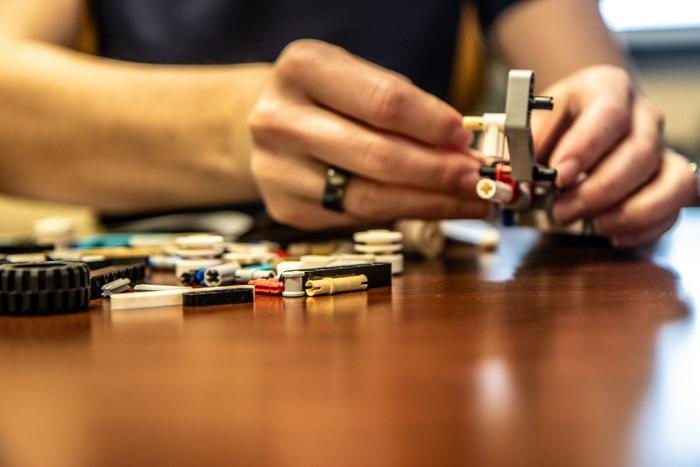A study from West Virginia University engineers demonstrates people’s completion of monotonous assembly tasks improves when doing those tasks involves playing a game.

Credit: WVU Photo/Nathaniel Godwin
A study from West Virginia University engineers demonstrates people’s completion of monotonous assembly tasks improves when doing those tasks involves playing a game.
The research, published in the journal Robotics and Computer-Integrated Manufacturing, examined the “gamification” of manufacturing tasks in order to improve workers’ well-being and productivity. The team’s findings suggest workers on factory assembly lines will be more productive, engaged and motivated — but also more stressed — if repetitive activities like fitting parts together are incentivized through competition or rewards.
Researcher Makenzie Dolly said gamification has become part of many people’s daily lives. In wellness, gamification shows up in the form of fitness tracking challenges. In marketing, popular forms of gamification include shopping rewards programs for food, coffee or clothing.
Now a teaching assistant professor at the WVU Benjamin M. Statler College of Engineering and Mineral Resources, Dolly was a Statler College doctoral student at the time of the study. With Ashish Nimbarte, professor and chair of the Department of Industrial and Management Systems Engineering, and Thorsten Wuest, associate professor, Dolly designed an experiment that simulated the monotony of a typical production assembly task using a toy Lego set.
Study participants were randomly assigned to a “gamified” group or a “control” group. Both groups had to assemble the same Lego model of a telehandler — an agricultural vehicle also known as a “reach forklift” or “cherry picker.” The telehandler has personal resonance for Dolly, who said that for her WVU senior project she worked for leading telehandler manufacturer JLG.
Participants in both the gamified and control groups were required to assemble the telehandler model 15 times over five separate occasions. Those in the gamified group, however, had their productivity measured and rewarded via game-like elements such as progress bars and badges.
Turning the work into a game significantly boosted the gamified group’s productivity by the time those participants got to their 15th build of the Lego kit. The researchers speculated the jump in completion times for the final attempt “may have been caused by participants’ last-ditch efforts to obtain a new personal record badge,” Dolly said. “We believe participants wanted to end the study on a high note by showcasing their best efforts.”
But gamification also amped up participants’ stress, to Dolly’s surprise.
“We expected gamification would lessen participants’ perceived workloads,” she said. “Instead, it increased the frustration, effort, time pressure, and mental and physical demands they reported experiencing. Participants in the gamified group performed better than those in the non-gamified group, but they believed they did worse.”
According to Dolly, that’s not as bad as it sounds. The “psychological load” that gamification places on workers encourages them to be more mentally active and engaged in the task at hand. As long as stress levels aren’t extreme or unnecessary, that extra pressure drives better performance, she said.
“There has to be some kind of risk or motivation keeping people engaged during repetitive assembly tasks. When tasks are too monotonous, mistakes happen and workers ‘bore out’ or silently quit. If we introduce the risk of losing a game into those tasks, then they feel a sense of urgency that drives productivity and quality.”
Participants who said they tended to be “self-competitive,” driven to try to beat their own records, felt the pressure of time most acutely. Those who identified as impatient tended to get most frustrated during the builds and to feel most burdened by the physical demands of the task.
“The fact that we saw physical demand and frustration levels rise as patience levels decreased means that anyone designing a gamification application needs to consider the level of tolerance a user will have for more difficult scenarios,” Dolly said.
“Step one should be knowing the workers’ personalities and levels of patience with hard tasks. Every individual has their own threshold for what level of challenge and stress is helpful, and pushing employees past that point can lead to high turnover and sick leave. When it comes to gamification, workers need to be in that sweet spot between boredom and overwhelm.”
Journal
Robotics and Computer-Integrated Manufacturing
DOI
10.1016/j.rcim.2024.102722
Article Title
The effects of gamification for manufacturing (GfM) on workers and production in industrial assembly
Article Publication Date
19-Jan-2024



